 Jeep Liberty: Supplemental Active Head Restraints (AHR)
Jeep Liberty: Supplemental Active Head Restraints (AHR)
These head restraints are passive, deployable components, and vehicles with this equipment cannot be readily identified by any markings, only through visual inspection of the head restraint. The head restraint will be split in two halves, with the front half being soft foam and trim, the back half being decorative plastic.
How The Active Head Restraints (AHR) Work
The Occupant Restraint Controller (ORC) determines whether the severity, or type of rear impact will require the Active Head Restraints (AHR) to deploy. If a rear impact requires deployment, both the driver and front passenger seat AHRs will be deployed.
When AHRs deploy during a rear impact, the front half of the head restraint extends forward to minimize the gap between the back of the occupant’s head and the AHR.
This system is designed to help prevent or reduce the extent of injuries to the driver and front passenger in certain types of rear impacts.
NOTE: The Active Head Restraints (AHR) may or may not deploy in the event of a front or side impact.
However if during a front impact, a secondary rear impact occurs, the AHR may deploy based on the severity and type of the impact.
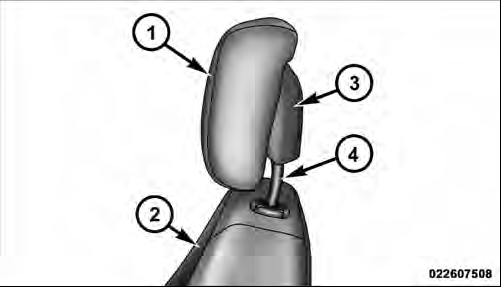
Active Head Restraint (AHR) Components
1 — Head Restraint Front Half (Soft Foam and Trim)
2 — Seatback
3 — Head Restraint Back Half (Decorative Plastic Rear Cover)
4 — Head Restraint Guide Tubes
CAUTION!
All occupants, including the driver, should not operate
a vehicle or sit in a vehicle’s seat until the head
restraints are placed in their proper positions in order
to minimize the risk of neck injury in the event of an
accident.
NOTE: For more information on properly adjusting and positioning the head restraint, refer to “Adjusting Active Head Restraints” in “Understanding The Features Of Your Vehicle”.
Resetting Active Head Restraints (AHR)
If the Active Head Restraints are triggered in an accident, you must reset the head restraint on the driver’s and front passenger seat. You can recognize when the Active Head Restraint has been triggered by the fact that they have moved forward (as shown in step three of the resetting procedure).
1. Grasp the deployed AHR from the rear seat.
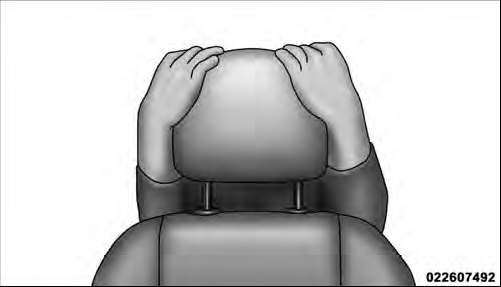
Hand Positioning Points On AHR
2. Position the hands on the top of the deployed AHR at a comfortable position.
3. Pull down then rearward towards the rear of the vehicle then down to engage the locking mechanism.
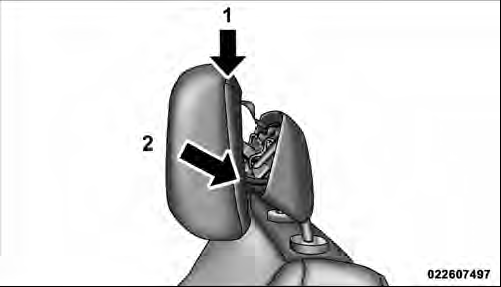
1 — Downward Movement
2 — Rearward Movement
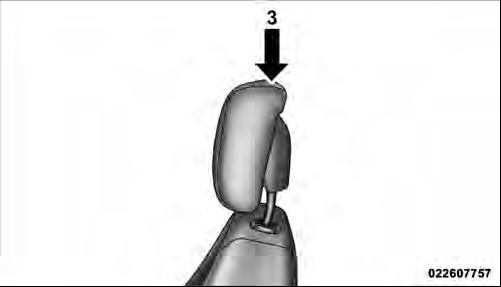
3 — Final Downward Movement To Engage Locking Mechanism
4. The AHR front soft foam and trim half should lock into the back decorative plastic half.
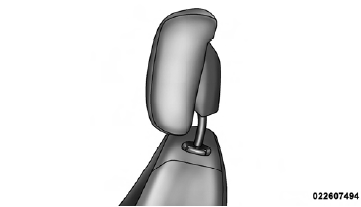
AHR In Reset Position
NOTE:
• If you have difficulties or problems resetting the
Active Head Restraints, see an authorized dealer.
• For safety reasons, have the Active Head Restraints checked by a qualified specialist at an authorized dealer.
 Seat Belt Pretensioner
Seat Belt Pretensioner
The belt for driver seating position is equipped with a
retractor pretensioning device, the belt for passenger
seating position is equipped with both retractor and
buckle pretensioning devices. ...
 Enhanced Seat Belt Use Reminder System (BeltAlert )
Enhanced Seat Belt Use Reminder System (BeltAlert )
BeltAlert is a feature intended to remind the driver and
front passenger (if equipped with front passenger
BeltAlert ) to fasten their seat belts. The feature is active
whenever the ignition is ...
See also:
Stop/Tail/Turn Signal/ Sidemarker Lamp
To replace one of these lamps:
1. Open the liftgate. See Liftgate on page 2‑9.
2. Remove the two screw covers from the taillamp assembly.
3. Remove the two screws securing the taillamp asse ...
Automatic connection
When the Bluetooth® function is active and the
most recently paired device is within range, it
is automatically connected. When the infotainment
system searches for the most recently
paired d ...
Tilt operation
Tilt operation
Pull the lock lever down 1 and adjust the
steering wheel up or down 2 to the desired
position.
Push the lock lever up 3 securely to lock the
steering wheel in place. A clickin ...
